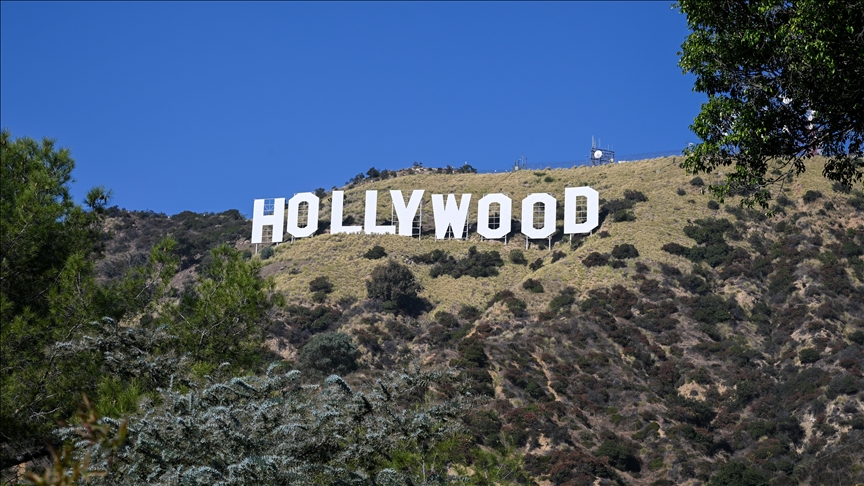Trump aims to revitalize Hollywood via 100% film tariff
-US movie production declining in recent years; film tariff may not be effective as other countries offer tax incentives, low labor costs

BRUSSELS/WASHINGTON
US President Donald Trump is seeking to regain the country’s weakening leadership in the global movie industry with new tariffs in a bid to revitalize Hollywood’s business.
“The Movie Industry in America is DYING a very fast death,” the president said Sunday in a Truth Social post.
Trump instructed the Commerce Department and the US Trade Representative to “immediately begin the process of instituting a 100% Tariff on any and all Movies” made outside the US. Commerce Secretary Howard Lutnick agreed, writing, “We’re on it” via X.
Trump said in a statement at the White House on Monday that he would meet representatives of the movie industry to help, claiming that “Hollywood is being destroyed.”
He blamed California Gov. Gavin Newsom for allowing “that to happen,” and “other nations have stolen” the US film industry.
Trump softened his tone, however, following backlash to his 100% tariff on movies made outside the US, saying he would meet industry representatives to “make sure they’re happy with it because we’re all about jobs.”
Trump’s tariff announcement came after he met Jon Voight, actor and Special Ambassador to Hollywood, at Mar-a-Lago, which caused controversy in the US film industry.
Voight released a video on X, “Plan to rescue Hollywood,” in which he said many Americans lost jobs in the industry as production moved overseas.
- Movie production worldwide
Movie production around the world has been on an upward trend, as data from the World Intellectual Property Organization (WIPO) showed that the industry saw historical highs after recovering from the coronavirus pandemic.
A total of 3,896 movies were produced in 2003, according to the WIPO. That figure rose to 9,328 in 2019.
Movie production suffered from the restrictions that the pandemic brought in its wake, as the number of movies produced declined 40% to 5,656 in 2020 but recovered to 7,827 in 2021, 8,833 in 2022 and 9,511 in 2023.
India remains number one in annual movie production in the world with 2,562 films made in 2023, a stark difference compared to 2003’s figure of 877.
China is number two, rising from 140 in 2003 to 792 movies in 2023, followed by Japan with 287 movies in 2003 and 676 in 2023.
Meanwhile, the US ranks fourth in annual film production and its figures are on the decline, while India, China and Japan produce more movies every year.
The US annual movie production was 943 in 2021, which fell to 803 in 2022 and 510 in 2023, in contrast to 20 years ago, when the country produced 593 in 2003.
The global movie industry was hit by the pandemic and while it has been in recovery, actors and screenwriters have been on strike in the US, disrupting production.
Wildfires in Los Angeles earlier this year also affected movie production in Hollywood, while more advantageous places with attractive tax incentives and low labor costs came to the fore to replace the US as locations in film-making.
US-based Motion Picture Association (MPA) data showed that the movie and television industry directly employed 856,000 workers in the US in 2023, while employers in the industry paid $102 billion in wages and bought $21 billion in services to local companies.
The American film industry exported $22.6 billion in 2023 and a trade surplus of $15.3 billion was recorded.
ProdPro’s “2025 TV and Film Outlook Report” revealed that global competition runs on production and tax incentives, as last year, the US ranked first in movie production costs, where shooting a film is the most expensive, with $14.5 billion, followed by the UK at $6.9 billion, Canada with $5.4 billion and Australia with $2 billion.
The US states of California, New York and Texas announced more tax breaks to attract movie production, while British Columbia in Canada -- a fast-growing region for filmmakers -- increased tax breaks to 36% and offered additional bonuses for high-budget production projects.
The UK updated tax breaks for creative industries, offering up to 39.75% tax cuts for low-budget movies, while Australia provides up to a 40% tax break for high-budget films with local incentive packages.
Germany introduced a 30% tax incentive for movie and TV production and required investments in domestic entertainment production. Hungary extended its $3 billion movie production incentive for six years.
- Trump’s plan remains unclear
Trump announced 100% tariffs on movies, but it is still unclear how such a policy will be imposed or to whom.
Experts said the complex nature of the movie industry, whether it be the production or the distribution, makes film tariffs difficult to enforce.
As movie production moved abroad, the American film industry suffered. Experts advise that tariffs may not be the appropriate solution to the problem.
Incentives such as tax cuts would be more effective in helping Hollywood recover from the downward trend in film production, according to experts.








